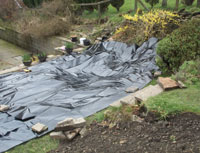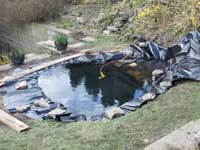
Pond liner
Butyl liner is the most flexible, but most expensive liner available. Water-Garden.co.uk (see links) supply a wide range of pond liners and accessories I used a heavy duty polythene underlay between the sand and the main liner. Next time I would use a fabric underlay instead, as the polythene ones are not as easy to fit neatly. They also hold water and you end up with a pond inside a pond as it were.
To calculate the size of pond liner proceed as follows:-
Length of liner = twice maximum depth of pond + maximum length of
pond + 1m (3' 3") excess.
Width of liner = twice maximum depth of pond + maximum width of
pond + 1m (3' 3") excess.
If you are using a fabric underlay on top of the sand layer (recommended) lay it centrally over the pond and mould it into the pond's contours.
 |
Now for the liner. Make sure that the weather is relatively warm as the liner will be more flexible. Lay it centrally across, not inside, the pond. |
Weigh down the edges with stones and fill slowly with the garden hose. The liner will stretch to most of the contours. As the water level rises move the stones to allow the liner to sink into the pond. Complex or sharp curves will need the liner folding or shaping with the hands. |
 |
Leave the water and liner to settle. Check the surface for level and adjust the soil as necessary. Trim excess liner, leaving at least 15cm (6") all the way round. Peg down the liner edge.
Construction Pages
Page 1 Some considerations |
Page 2 Wildlife or Fish? |
Page 3 Pond Materials |
Page 4 Get Digging! |
You are on page 5 of 8 |
Page 6 Finishing Touches |
Page 7 Plants - oxygenators |
Page 8 Plants - Marginals |
Frogs, frogspawn & tadpoles - page [1]
[2]![]() Main
Pond Page
Main
Pond Page